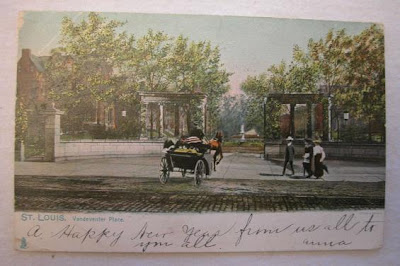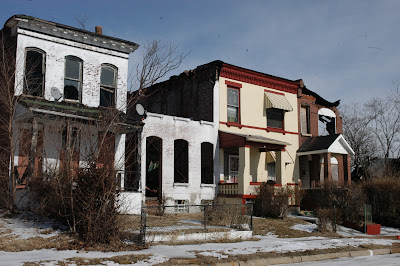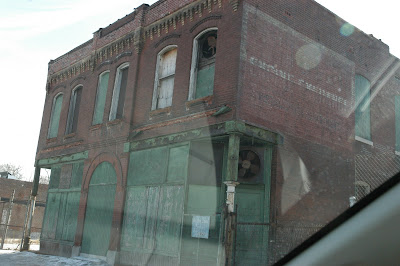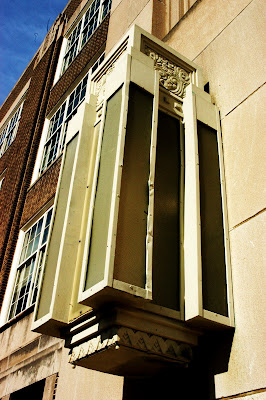You gotta love that street grid, no? A true rectilinear beauty.
The 2000 census counted 2,209 residents (40% decline from 1990) of whom 97% were black, 1% white. There were 1,183 housing units that were 71% occupied, split 50%/50% owner/renter.
40% loss of residents....wow. That sucks. And it doesn't get much better based on the additional loss of 24% from 2000-2010. Black people are voting with their feet and leaving in droves.
From the neighborhood website:
Vandeventer residents strive to improve the area and reverse the current deterioration trend. They participate in various organizations to build a better and stronger community. Some of the organizations are: Citizens for a Better Community, Block Units, Urban League, SLACO, Neighbor to Neighbor, Americorps, Weed 'n Seed, and a Community Council. More resident participation is needed.I like the honesty about more resident participation being needed.
Here's a snippet from the Wikipedia page:
Founder, Peter Lewis Vandeventer, came to St. Louis in the 1860's. He, along with his brothers, William and Henry Barnum Vandeventer, bought large parcels of land in Missouri for development.
A private place in the neighborhood, Vandeventer Place, was a gated, luxury complex with large mansions and a beautiful fountain as its centerpiece. The fountain and front gates survive in Forest Park.
Peter Lewis Vandeventer and Henry Barnum Vandeventer were Wall Street stock brokers with a firm located at 6 Wall St., New York City. They made their money from selling stocks and took the train west to St. Louis and invested it in land.
Peter Lewis Vandeventer died in 1879, during the development of Vandeventer Place. His Missouri estate was managed by several corrupt lawyers, who stole much of the money from the sale of the lots at Vandeventer Place. His family remained in St. Louis for some time after his death, living at Vandeventer Place in a large mansion.Another quote from wikipedia on the "obliterated" Vandeventer Place:
Vandeventer Place, opened in 1870 and included a house design by H.H. Richardson. Vandeventer Place has been completely obliterated, with the exception of the east gate, which was removed to Forest Park.These gates are visible today right by the Jewel Box in Forest Park. They were moved there in 1950. There's a nice write up of the gates at the St. Louis Patina blog:
after (source)
And another great picture here:
after (source)
We've picniced here many times over the years, and my kids love climbing all over these gates. I always naively assumed they were relics from the World's Fair and framed some exhibit; they just seem so out of place. I'm glad they were saved because not much else from Vandeventer Place remains
More on the history of Vandeventer Place:
Although preceded by such havens for abodes of the affluent as Lucas and Grand Prairie Places, the St. Louis private street concept reached its initial grandeur in Vandeventer Place, designed by Julius Pitzman in 1870. It was named for Peter L. Vandeventer, who owned the tract bounded by Grand, Bell, Enright and Vandeventer Avenues, where it was developed. Vandeventer Place was conceived by Charles H. Peck, Napoleon Mulliken and John McCune. It was to be a most fashionable private street with stringent restrictions relating to its occupants and exclusiveness in prohibiting any kind of noxious intrusion. It was administered by an association of all of its property owners, ever alert to maintain the Place's air of genteel elegance.You know, it's easy to wax nostalgic for the days when America was a manufacturing super power, but the city must have been a pretty nasty place due to nearby mining, pollution and coal ash everywhere.
The first houses to be erected were those of the street's founders in 1871. They were all situated near the Grand Avenue entrance, which was guarded by a huge iron gate. This gate was later replaced by a monumental limestone entrance structure, with a circular pool and a fountain in the nearby central parkway. The eastern one of these entrance porticoes, which were at both ends of the Place, is now located near the Jewel Box in Forest Park.
Vandeventer Place reached the pinnacle of its glory in the 1890's, when it contained the luxurious mansions of the City's wealthiest citizens. Among these were David R. Franci former mayor, governor, and later president of the World's Fair and H. Clay Pierce, an oil magnate whose home was-said to have cost $800,000 in the days of low construction costs.
Architecturally notable was the John R. Lionberger house at 27 Vandeventer Place, designed by the famed Boston architect, Henry H. Richarason, in 1886. The J.G. Chapman residence at Number 46 was the work of the St. Louis firm of Eames and Young in 1892. Its last occupant was John L. Mauran, the well-known St. Louis architect.
By 1910, the noise, smoke and dirt of the City had surrounded Vandeventer Place, which began a valiant ef fort to maintain its high standards . However, it proved to be a losing battle, culminating in surrender in 1947 when the Veterans' Administration acquired the eastern half of the Place as the site for its new hospital. The final blow came when the City acquired the western portion about ten years later as the site for a childrens detention home.
Some post cards from the glory days of Vandeventer Place:
And just west of the all important Covenant Blu/Grand Center with it's arts and theater district:
Sadly, in many ways Vandeventer is the end of the optimism that the central corridor has to offer. Vandeventer today is many years and many dollars away from being a contiguous neighborhood. There are many, many fallow fields where homes and buildings once stood.
Unfortunately, it's a study in slow decay.
Most businesses left as well.
There's some business on Delmar, Page and Martin Luther King Jr Blvd. Here are a few:
Some local fare...who wants to go on a pic-a-nic?
There are quite a few of the former classics still standing in various states of repair that serve as a reminder that this was once a fantastic place.
Now you might look at all the falling structures and abandonment and say well, the former residents and the city gave up on this one. And they clearly have, as there is little evidence of physical property stabilization efforts, investment or otherwise. Heck, 40% of the residents left in a 10 year span from 1990-2000.
There are those with good intentions who are erecting suburban contemporary structures that make absolutely no attempt to fit in with the St. Louis classics and one made Vandeventer great. You could argue this construction is even a setback to progress. Is there no city code to prevent this kind of thing:
There are some more unique looking contemporary homes that exist as well, in fact I haven't seen any like this yet:
Check out the lack of curb cuts on these cooler looking modern homes on Delmar.
And of course strip malls:
This strip mall houses the Greater Ville Preservation Commission, which is located in Vandeventer, go figure.
My favorite buildings in Vandeventer are the Cole School:
And I love this stretch of buildings on Delmar:
And, probably my favorite home in Vandeventer:
I've noticed in my travels through the city that outside of fast food restaurants and drive through banks, contemporary churches have to be the worst anti-urban structures in North City. I know churches themselves are important to the community, it's the way they are built that is so thoughtless. Massive surface parking lots sometimes fenced in with a small church on a huge expanse of land. These rob the original urban fabric and design of the neighborhood.
Yet, there are other churches in Vandeventer that do indeed fit in with the remaining original fabric of the neigborhood:
The fact remains, Delmar is a psychological, economic and racial dividing line in our city. I'd like to hear all arguments to the contrary, but this just can't be a mistake. It's glaring. The Central West End is arguably St. Louis' premier, swankiest neigborhood, but cross Delmar and head north and you'd think you were in another world.












































































St. Louis is both completely amazing and also totally sad. The history of Vandeventer Place illustrates this perfectly.
ReplyDelete^you summed it up Anon, that's my take too. We can't continue to turn our backs on these parts of town, we must imbrace them and attract people. I say give all the abandoned property away to any American citizen who will sign a contract to bring it up to code and live there for 10 years. Here are the keys, welcome to Vandeventer!!!! It's that easy :)
ReplyDelete^ Unfortunately it's not that simple. the city would LOVE to give property to someone with a plan and the money to actually stabilize/revitalize any of these buildings. There simply aren't enough people who want to do so.
ReplyDelete^anon 11:01 AM, the LRA should advertise and market the property in all media forms to prospective buyers...in many cities. Advertise the properties in expensive cities like Chicago, San Fran, Boston, NYC, etc and offer the properties for free if you promise to get it up to code and live there for 10 years. we not pioneers and there aren't enough in STL that are willing to take the chance or have the means to make it happen. LRA needs to look elsewhere for buyers.
ReplyDelete^ we need pioneers, not we not pioneers, sorry
ReplyDeleteBack in 09 I took pics by the stone columns in Forest Park. I never knew that was part of the Vandeventer area. Saint Louis is the most under used city. I wish I had the $$$ I would buy up these open plots of land, that sale for about $1500 through the LRA, and bring back the beauty of this great city!!
ReplyDeleteAaron
You guys are right - this neighborhood is a great microcasm of what's gone wrong. I don't know if I'm happy or sad that some of the more modern buildings look like they were built to last. I'd be interested in seeing how much of the land in this neighborhood and others north of Delmar have been bought by Paul McKee. That would be an interesting addition to the write-ups on these neighborhoods.
ReplyDeleteInteresting, no comment of Ranken Technical College who has been in the neighborhood since 1907. And is the major player in new construction in the area.
ReplyDelete^Brian S. I thought Ranken was in the Lewis Place neighborhood.
ReplyDeleteI drove down Delmar from Euclid to
ReplyDeleteVandeventer and was surprisedto see
a number of new houses and some re-
habbed houses. These were the first signs of improvements on this
street I have seen for all my 70 plus years.